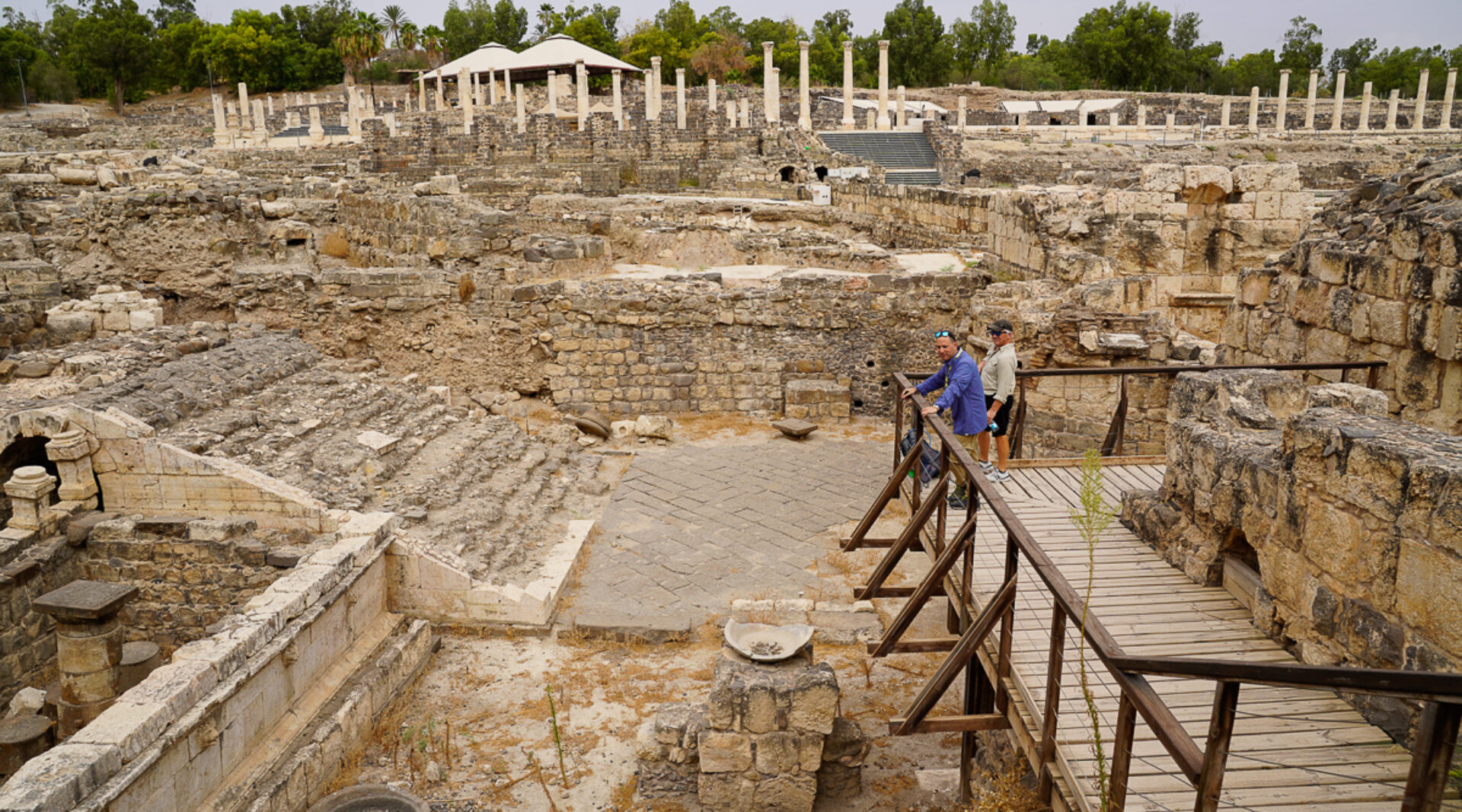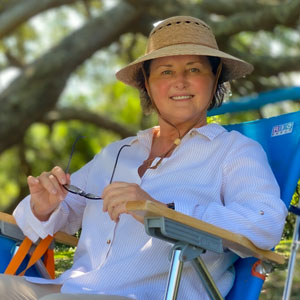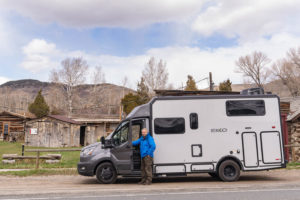What Happened at These Archaeological Sites in Israel?
“God changed Abram’s name to Abraham, and made him the father of nations.” – Genesis 17:1-14
We stood atop mounds that held over 4000 years of history. As many as 20 distinct civilizations lay buried beneath our feet. The magnitude of humanity was impossible to imagine. With our well-informed Archaeological Paths guide, Alon Yitzhaki, our group of seven travelers learned a little about the rich tapestry of life revealed at the archaeological sites in Israel.
Tel Megiddo (5000 to 350 BCE) One of the most important archaeological sites in Israel
We entered Tel Megiddo through the Israelite Gate. During the Iron Age, King Solomon transformed the area into a royal city, part of the Kingdom of Israel.
Reaching the summit, we could see why Megiddo was an important geographical location.
The Jezreel Valley lay before us. Flat and fertile, it provided an essential source of food in ancient times that continues to this day. The international trade route (Via Maris) crossed the valley and linked Egypt with Mesopotamia and Asia Minor (Anatolia). The people of Megiddo captured water from two natural springs. As thousands of visitors do each year, we descended 170 stairs to see how people reached the water at Megiddo.
Canaanites inhabited Megiddo during the Bronze Age. During the later part of this period, Egyptian King Thutmose III conquered the rebellious Canaanites and their coalition—the Battle of Megiddo is one of many battles at the site. Inscriptions at the Temple of Karnak in Luxor, Egypt, show the list of the riches seized. These include thousands of people and livestock, grains, cooking utensils, tools, chariots, and items inlaid with precious and semi-precious stones. “Thutmose III’s Battle of Megiddo Inscription.” – (Mark, J.J. 2017, July 25)
Today, Tel Megiddo is an active archaeological site and a UNESCO World Heritage Site. The closest settlement is the Megiddo Kibbutz, located in the Jezreel Valley. The latest battle at Megiddo occurred in 1918 when British Field Marshall Edmund Allenby defeated the Ottomans and earned the unofficial title of “Armageddon General.”
The Hebrew name for Megiddo is Armageddon.
Many believe the final battle outlined in the Book of Revelation will occur in the Jezreel Valley.
Tzippori National Park – Beautiful mosaics of archaeological sites in Israel
Tzippori was the capital and center of religious and cultural activity in Roman and Byzantine times. The richness of the city is seen in its streets.
A network of streets in Tzippori is made of beautiful mosaic designs. Some are indented with the grooves of chariot wheels!
People might have shopped for a mosaic floor at the market during those times. Selections included figures of animals and people, beautiful patterns, and colors. A mansion at the top of the hill shows a beautiful dining hall floor. The mosaic depicts the life of Dionysus, the God of wine-making. Colorful details show the pink cheeks on the face of a beautiful woman. It’s known as “the Mona Lisa of Tzippori.”
As we walked, our guide fueled our imaginations with compelling stories. With little work in Nazareth, it’s plausible that Joseph would have visited nearby Tzippori to do carpentry work. Jesus, as a boy, would have accompanied Joseph and likely have begun forming his first impressions of the differences between the rich and the poor.
The mosaics were a marvel, but the thought of Jesus as a boy in Tzippori is a treasure!
Stopping for lunch along the Sea of Galilee, I ordered fish, scored, and grilled whole. “What kind of fish is this?” I asked. “Peter’s fish!” the manager replied. He used that line many times, I thought. Everyone else seemed to know that the fish was Tilapia.
Capernaum Archeological Site – “The Town of Jesus”
Jesus recruited his disciples, performed miracles, and preached in the Capernaum Synagogue. That’s why, at the gate, the sign reads, “The Town of Jesus.” It is said that Jesus may have stayed with Peter, whose house was directly across from the Synagogue. The foundation of Peter’s home is preserved and visible through a thick glass floor. It is covered by an awning that forms St. Peter’s Church, Capernaum, a modern Catholic pilgrimage church. Today, the church is part of the Franciscan monastery.
The ruins of the Capernaum Synagogue called the White Synagogue, date to the fourth century CE. It is built on the foundations of a first-century structure believed to be the synagogue where Jesus gave his sermons. In addition to being a pilgrimage site, Capernaum is one of many archaeological sites in Israel.
Magdala Archaeological Park – One of the most recent of the archaeological sites in Israel
The Magdala Hotel is located on the western shore of the Sea of Galilee. The on-site church, Duc in Altum, is open to all denominations. The meaning of the church’s name comes from the words Jesus said to Peter, “put out into the deep.”
The hotel, completed in 2019, started as a vision of Father Juan Solana, a Catholic Priest. He wanted a quiet place for pilgrims to worship. Soon after starting the project, workers began finding clues to something special.
First, they found the remains of the ancient fishing pier, and then, they discovered one of the most important archaeological sites in recent history, a First Century Synagogue. It is one of nine in Israel and the oldest in Galilee.
During the excavation, workers uncovered the Magdala Stone. It would have been used to hold the Torah and Scrolls. According to The Israel Antiquities Authority, “the Magdala Stone is one of the most important archaeological discoveries in Israel’s history.” (Israel Antiquities Authority “The Magdala Stone,” Magdala.org) The menorah carving on the stone is one of the earliest depictions. That and other carvings provide valuable information from when the Second Temple of Jerusalem stood. The stone also confirmed that synagogues were sacred places, not just for education and storing materials. The original Magdala Stone is in a museum, and a replica is at the site.
Mary Magdalene lived in the fishing village of Magdala. A faithful follower of Jesus, she witnessed his crucifixion and resurrection. Our guide, Alon, was excited to share this latest of archaeology sites in Israel. “Jesus would have surely preached at this site!” he said.
Beit She’an National Park – One of the most interesting archaeological sites in Israel
The area of Beit She’an, including the tel above the city, may hold the remains of one of the oldest civilizations, dating to the Neolithic and Chalcolithic periods (7000 BCE – 2500 BCE.) Early periods saw the Egyptians, Canaanites, and Philistines there. “When the Israelites failed to conquer the Canaanite Beit She’an, Philistine Lords displayed the heads of Saul and his sons on the city walls.” – Beit She’an National Park, from Biblical references.
Most of the structures visitors see at Beit She’an come from the Roman and Byzantine eras (63 BCE.) Beautiful Byzantine mosaics are held in the Israel Library. As a Roman in Beit She’an, you’d have many options for a leisurely day. Enjoy a show in the three-tiered 7,000-seat Theater (one tier remains today.) From there, you could conveniently access a public lavatory.
The Roman lavatory has perfect ergonomically slanted marble toilet seats in a courtyard of stunning mosaic tiles.
Shop in the three-story public market, then pamper your tired body with a mani-pedi and skin treatment. Allow an attendant to clear your pores with a unique scraping tool. Archaeologists discovered these pampering tools near the public baths, where as a Roman, you might lounge as you reflect on a successful day. Two bathhouses (one covering 2.2 acres) are complete with hot, tepid, and cold treatments. Ahh, the life of the Romans, I thought! Beit She’an is one of the most interesting archaeological sites in Israel.
“Under Roman rule, the demography of Beit She’an included pagans, Jews, and Samaritans. The city thrived and expanded, a time of magnificent building.” – Bet She’an National Park.
The marble and granite structural remains built by the 2nd Century Romans are breathtaking, even after severe earthquake damage in 749 CE.
Masada National Park – the most breathtaking of the archaeological sites in Israel
Masada is located one thousand three hundred feet above the Dead Sea. The mini-series Masada (1981) tells of the epic self-sacrifice of the 960 Jewish rebels who faced a Roman siege at Masada. Still alive after the Romans entered, Flavius Josephus describes the scene in signage quoted at the site.
“The Romans, expecting further opposition, were at a loss to conjecture what had happened… Here, encountering the mass of the slain, instead of rejoicing over enemies, they admired the nobility of their resolve and the contempt of death displayed by so many for carrying it, unwavering, into execution.” – Flavius Josephus.
At the top of the plateau, we gazed over the rough terrain. The people at the top would have looked down from the same position to see the Romans working persistently for three years to breach their refuge.
We walked to the area that overlooked King Herod the Great’s palace—his lavish living quarters were situated on an outcrop of stone in the shade of a cliff. Cut-outs of the interior walls reveal the beauty. Elaborate tunnels channeled enough water from a single annual rainfall to cisterns that provided enough for one year. Replicas of the palace and the water channels at the site provide more information.
Jerusalem
We concluded our tour of the archaeological sites in Israel by visiting several locations in Jerusalem. We began at the Israel Museum at the Davidson Center and the 3-D model of ancient Jerusalem. The impressive model raised the hair on my arms as I pondered it!
Inside the museum, we viewed everything from modern-era artifacts of everyday Jewish life to ancient mosaic carpets taken from archaeological excavations in Beit She’an National Park.
The Shrine of the Book contains the ancient texts of the Dead Sea Scrolls.
The museum docent shared the incredible history of the Scrolls. The Bedouins found the ancient texts in caves. They were in a quandary. First, not knowing their value or not knowing who to tell, they often used them to light a fire or hid them in unprotected places. Once they learned the value, they started tearing them in pieces to get more money. Finally, wisened scholars began to offer more money for intact scrolls. Out of this, only one scroll is complete from the 15,000 scrolls and fragments in the Shrine of the Book. No pictures are allowed inside, but we saw the scrolls protected behind glass. The scrolls contain parts of every Book in the Hebrew canon (Old Testament).
We gathered at the Jaffe Gate for our tour of Old Jerusalem. The markets along the way were colorful and busy. Alon explained that following the 1967 War, the Jewish people, after years of expulsion, once again entered the city that they consider their most holy and sacred place.
The Temple Mount, the rock inside Old Jerusalem, is where God favored Abraham after he [Abraham] obeyed God and prepared to sacrifice his son. A piece of the rock is visible through a thick protective glass.
Today, Jerusalem is divided into four quarters: the Muslim Quarter, The Christian Quarter, the Armenian Quarter, and the Jewish Quarter. The Dome of the Rock is the place for worshipers of Islam. The Muslims believe that Abraham was willing to sacrifice his son, and the event occurred at the site. But they think it was the son of their ancestry that Abraham offered—only believers of the Islamist faith worship at the Dome of the Rock. A shrine at the Dome of the Rock is where Muslims believe the Prophet Muhammad ascended to heaven.
People of the Jewish faith pray at the Western Wall, their most sacred site. It is the only remaining wall at the Temple Mount of the ancient Jewish Temple.
The Church of the Holy Sepulchre is also located in the Old City of Jerusalem. It’s the place for Christian worship. People lined up to kneel at the site where many believe Jesus was crucified, buried, and resurrected. Colorful mosaics depict a touching scene of the events. My experience in the Old City of Jerusalem was mind-boggling and humbling. The crowds were overwhelming, and there was little time to digest the information. The ongoing restoration, with scaffolding and workers, added to the chaotic scene. But we were lucky; it took about two minutes to enter the Church. Alon said before COVID-19, it took two hours to enter.
We were not surprised to find the Western Wall crowded. We had the opportunity to pray there, men on one side and women on the other. Quickly finding a spot to touch with my hand, I turned towards it and prayed. As we departed the area, I turned to snap one last picture before leaving the Western Wall. Poignantly, the Dome of the Rock gleamed gold above the Wall.
Although not Jewish, touching the ancient wall and praying was a privilege that I treasure.
Later, we walked along Hezekiah’s Tunnel to view the Pool of Siloam, water fed by the Gihon Spring, which was carved there 3,000 years ago. The ancient system is part of the City of David Archaeological Site, another important archaeological site in Israel. “The Canaanite Pool,” as it was called then, is where King David brought his son Solomon to the priest Zadoc and the prophet Nathan to make him king over Israel. – Canaanite Pool inscription at the site. The spring is as essential to Jerusalem today as it was in ancient times. As noted on the sign, it is enough to fill 50,000 1.5-liter bottles per hour!
As we exited the tunnel along the wall surrounding Jerusalem, I was struck by the proximity of the Palestinian settlements outside the wall. Both the Palestinian and the Jewish settlements are adjacent to the Mount of Olives, where 70,000 and 150,000 tombs are located, including the tombs of famous figures in early modern Jewish history.
Our Guide – Archaeological Sites in Israel

Alon Yitzhaki is a Wine Expert, Sommelier, and licensed Tour Guide. He is the Founder, Co-Owner, and wine Tour Leader of Israel Wine Tour, a professional and experienced wine tour company in Israel, leading hundreds of private and group wine tours every year since 2008.
In this picture in Jerusalem, Alon demonstrates the ritual of purifying hands before eating.
Travel Notes
As we exited Jerusalem and drove through the Palestinian community to our hotel, I wondered how the Jewish people and Palestinians get along daily. Without going into the complexity of the subject, Alon explained that he’s comfortable on the streets of the Palestinian community.
“The people of each culture are not the issue, he said. “Nor are the tourists. We all gain from tourism.” – Alon Yitzhaki.
We can better understand our human history from the archaeological sites in Israel. However, they present an enormous task for archaeologists. The complexity of history includes natural and manmade disasters, such as earthquakes and wars, when artifacts are plundered or destroyed. As a visitor, grasping a tiny smidgeon of this ancient history was daunting, telling it even more. While visiting the sites, I sometimes felt overwhelmingly insignificant yet simultaneously blessed.
Our tour of Israel concluded on September 16, and we headed to Egypt. The Egypt tour ended on September 30th. Some of us stayed and toured Alexandria, others traveled to Jordan, while some of us, including me, traveled home to the U.S. I was at home on October 7th when the Hamas terrorists launched what is called “an unprecedented surprise attack on Israel and infiltrated the country by air, land, and sea.” – ABC News.
The picture below is Tel Aviv Beach, the first picture I took upon arriving in Tel Aviv. Looking back on the peaceful scene, I wonder why the world’s people, all children of Abraham, do not choose to live in peace. Naive, I know, but still, I wonder.








































